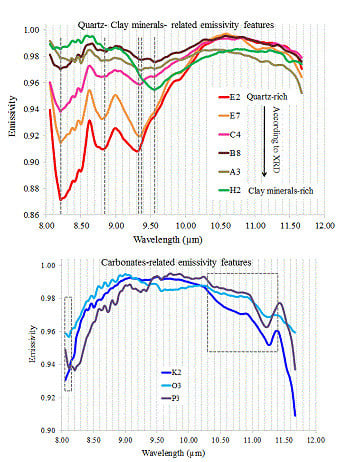Mineral Classification of Soils Using Hyperspectral Longwave Infrared (LWIR) Ground-Based Data
Abstract
:1. Introduction
2. Materials and Methods
2.1. Soil Samples and Chemical Analyses
2.2. Spectral Measurements and Data Analysis
3. Results and Discussion
4. Conclusions
Author Contributions
Funding
Conflicts of Interest
References
- Ben-Dor, E.; Banin, A. Quantitative analysis of convolved Thematic Mapper spectra of soils in the visible near-infrared and shortwave-infrared spectral regions (0.4–2.5 μm). Int. J. Remote Sens. 1995, 16, 3509–3528. [Google Scholar] [CrossRef]
- Chang, C.-W.; Laird, D.A.; Mausbach, M.J.; Hurburgh, C.R. Near-infrared reflectance spectroscopy–principal components regression analyses of soil properties. Soil Sci. Soc. Am. J. 2001, 65, 480–490. [Google Scholar] [CrossRef]
- Ben-Dor, E. Quantitative remote sensing of soil properties. Adv. Agron. 2002, 75, 173–243. [Google Scholar]
- Ben-Dor, E.; Chabrillat, S.; Demattê, J.A.M.; Taylor, G.R.; Hill, J.; Whiting, M.L.; Sommer, S. Using Imaging spectroscopy to study soil properties. Remote Sens. Environ. 2009, 113, S38–S55. [Google Scholar] [CrossRef]
- Viscarra Rossel, R.A.; Cattle, S.R.; Ortega, A.; Fouad, Y. In situ measurements of soil colour, mineral composition and clay content by VIS–NIR spectroscopy. Geoderma 2009, 150, 253–266. [Google Scholar] [CrossRef]
- Weng, Y.L.; Gong, P.; Zhu, Z.L. A spectral index for estimating soil salinity in the Yellow River Delta region of China using EO-1 Hyperion data. Pedosphere 2010, 20, 378–388. [Google Scholar] [CrossRef]
- Soriano-Disla, J.M.; Janik, L.J.; Viscarra Rossel, R.A.; Macdonald, L.M.; McLaughlin, M.J. The performance of visible, near-, and mid-infrared reflectance spectroscopy for prediction of soil physical, chemical, and biological properties. Appl. Spectrosc. Rev. 2014, 49, 139–186. [Google Scholar] [CrossRef]
- Eisele, A.; Lau, I.; Hewson, R.; Carter, D.; Wheaton, B.; Ong, C.; Cudahy, T.J.; Chabrillat, S.; Kaufmann, H. Applicability of the thermal infrared spectral region for the prediction of soil properties across semi-arid agricultural landscapes. Remote Sens. 2012, 4, 3265–3286. [Google Scholar] [CrossRef]
- Eisele, A.; Chabrillat, S.; Hecker, C.; Hewson, R.; Lau, I.C.; Rogass, C.; Segl, K.; Cudahy, T.J.; Udelhoven, T.; Hostert, P.; et al. Advantages using the thermal infrared (TIR) to detect and quantify semi-arid soil properties. Remote Sens. Environ. 2015, 163, 296–311. [Google Scholar] [CrossRef]
- Kopačková, V.; Ben-Dor, E.; Carmon, N.; Notesco, G. Modelling diverse soil attributes with visible to longwave infrared spectroscopy using PLSR employed by an automatic modelling engine. Remote Sens. 2017, 9, 134. [Google Scholar] [CrossRef]
- Hutengs, C.; Ludwig, B.; Jung, A.; Eisele, A.; Vohland, M. Comparison of portable and bench-top spectrometers for mid-infrared diffuse reflectance measurements of soils. Sensors 2018, 18, 993. [Google Scholar] [CrossRef] [PubMed]
- Notesco, G.; Ogen, Y.; Ben-Dor, E. Mineral classification of Makhtesh Ramon in Israel using hyperspectral longwave infrared (LWIR) remote-sensing data. Remote Sens. 2015, 7, 12282–12296. [Google Scholar] [CrossRef]
- Weksler, S.; Notesco, G.; Ben-Dor, E. An automated procedure for reducing atmospheric features and emphasizing surface emissivity in hyperspectral longwave infrared (LWIR) images. Int. J. Remote Sens. 2017, 38, 4481–4493. [Google Scholar] [CrossRef]
- McDowell, M.L.; Kruse, F.A. Integrated visible to near infrared, short wave infrared, and long wave infrared spectral analysis for surface composition mapping near Mountain Pass, California. In Algorithms and Technologies for Multispectral, Hyperspectral, and Ultraspectral Imagery XX; Proceedings of SPIE; Velez-Reyes, M., Kruse, F.A., Eds.; SPIE Press: Bellingham, DC, USA, 2015; Volume 9472. [Google Scholar] [CrossRef]
- Hecker, C.; van Ruitenbeek, F.J.A.; Bakker, W.H.; Fagbohun, B.J.; Riley, D.; van der Werff, H.M.A.; van der Meer, F.D. Mapping the wavelength position of mineral features in hyperspectral thermal infrared data. Int. J. Appl. Earth Obs. Geoinf. 2019, 79, 133–140. [Google Scholar] [CrossRef]
- TELOPS Hyperspectral IR Cameras. Available online: Telops.com/products/hyperspectral-cameras (accessed on 16 April 2019).
- Ben-Dor, E.; Banin, A. Visible and near-infrared (0.4–1.1 µm) analysis of arid and semiarid soils. Remote Sens. Environ. 1994, 48, 261–274. [Google Scholar] [CrossRef]
- Singer, A.; Berkgaut, V. Cation exchange properties of hydrothermally treated coal fly ash. Environ. Sci. Technol. 1995, 29, 1748–1753. [Google Scholar] [CrossRef] [PubMed]
- Notesco, G.; Kopačková, V.; Rojík, P.; Schwartz, G.; Livne, I.; Ben-Dor, E. Mineral classification of land surface using multispectral LWIR and hyperspectral SWIR remote-sensing data: A case study over the Sokolov Lignite Open-Pit Mines, the Czech Republic. Remote Sens. 2014, 6, 7005–7025. [Google Scholar] [CrossRef]
- Labsphare Infragold Targets. Available online: https://www.labsphere.com/labsphere-products-solutions (accessed on 16 April 2019).
- The Arizona State University Spectral Library. Available online: http://speclib.asu.edu (accessed on 1 June 2019).
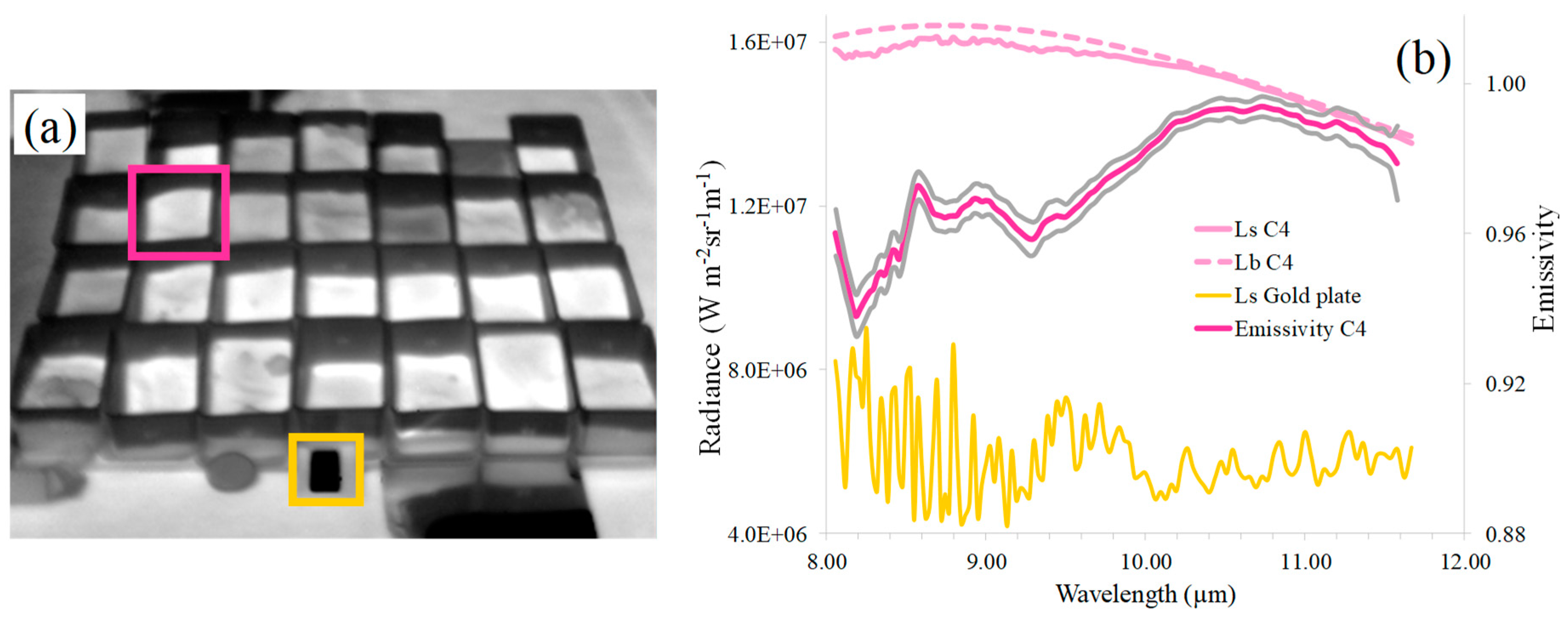
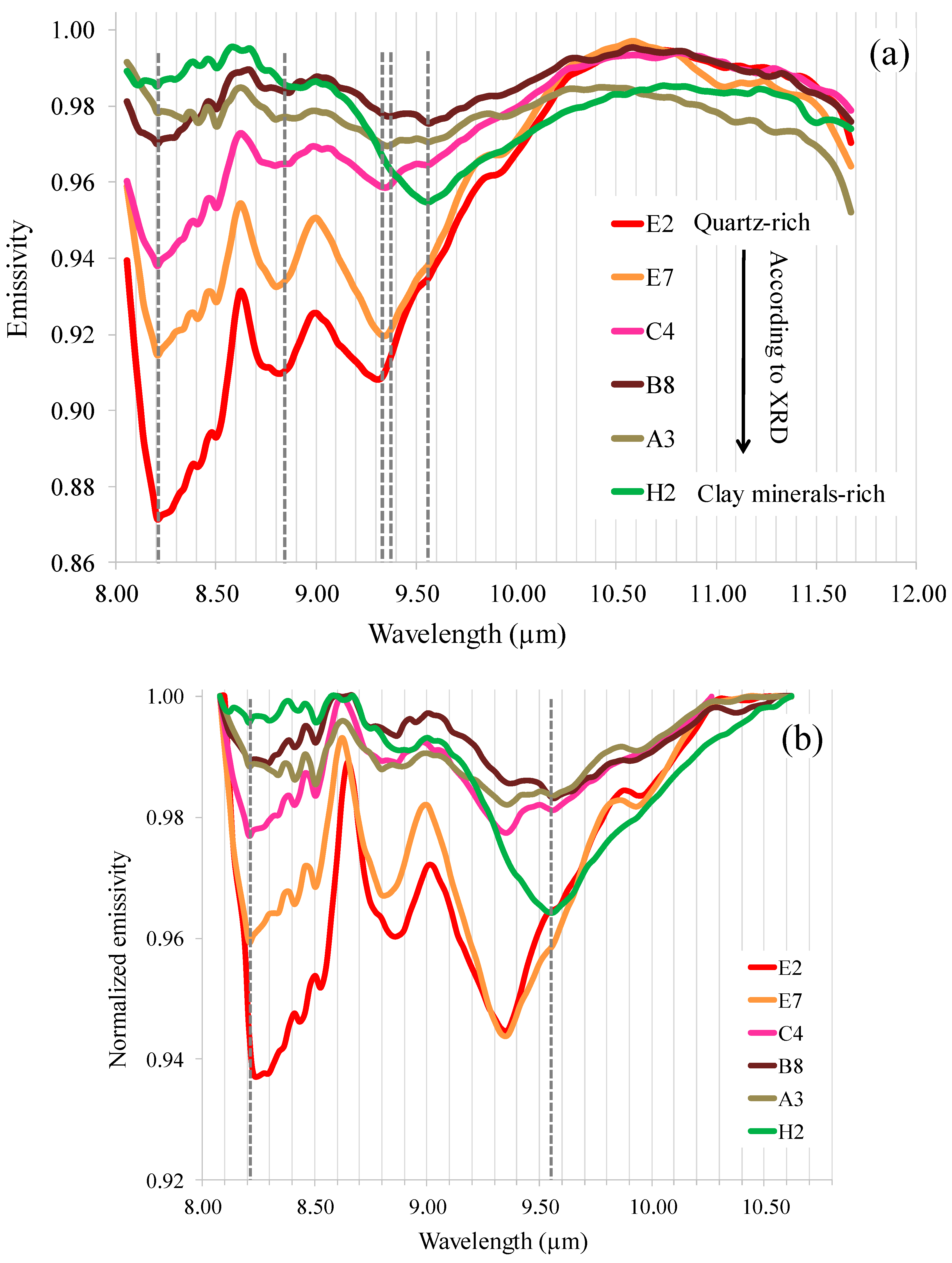
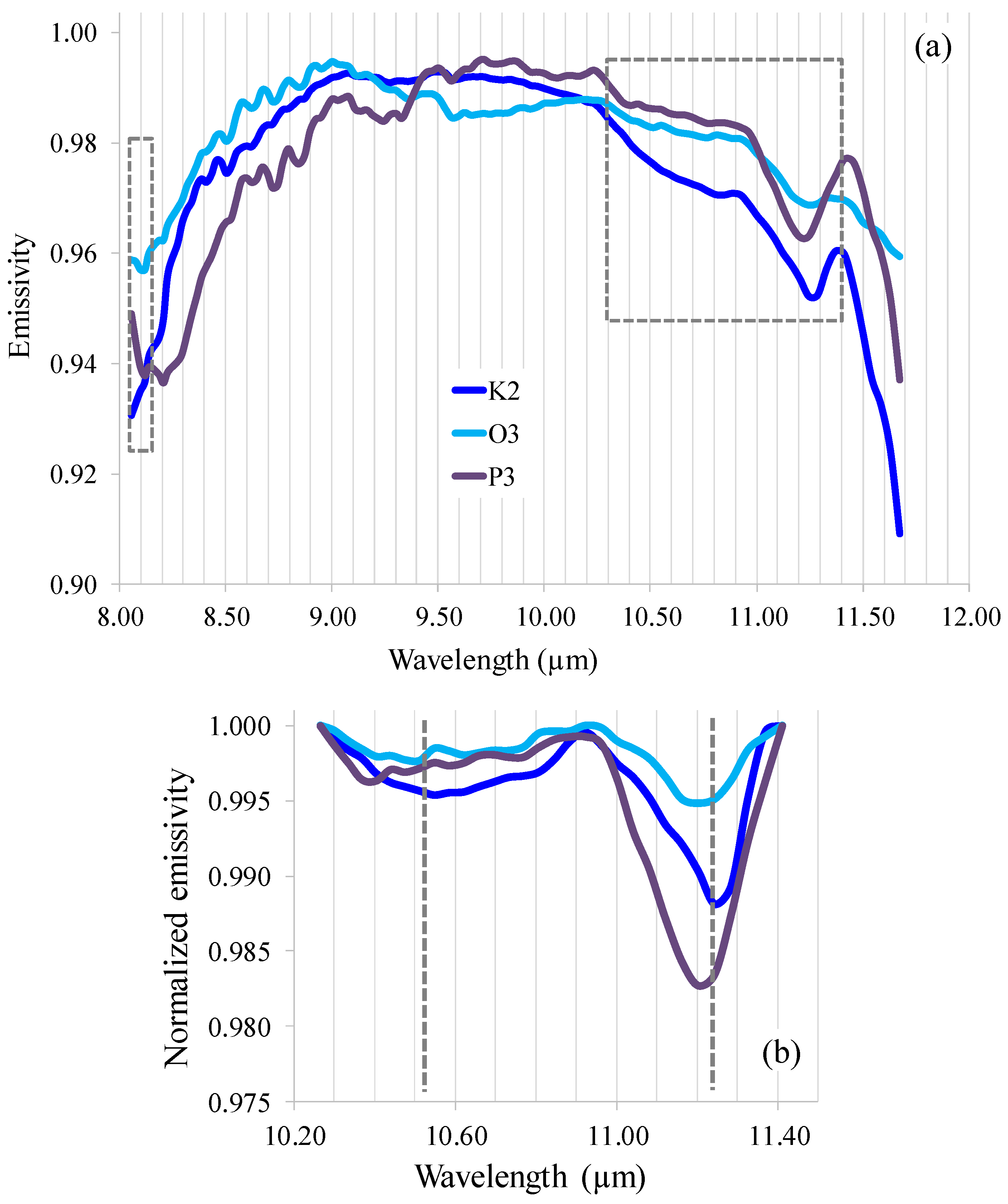


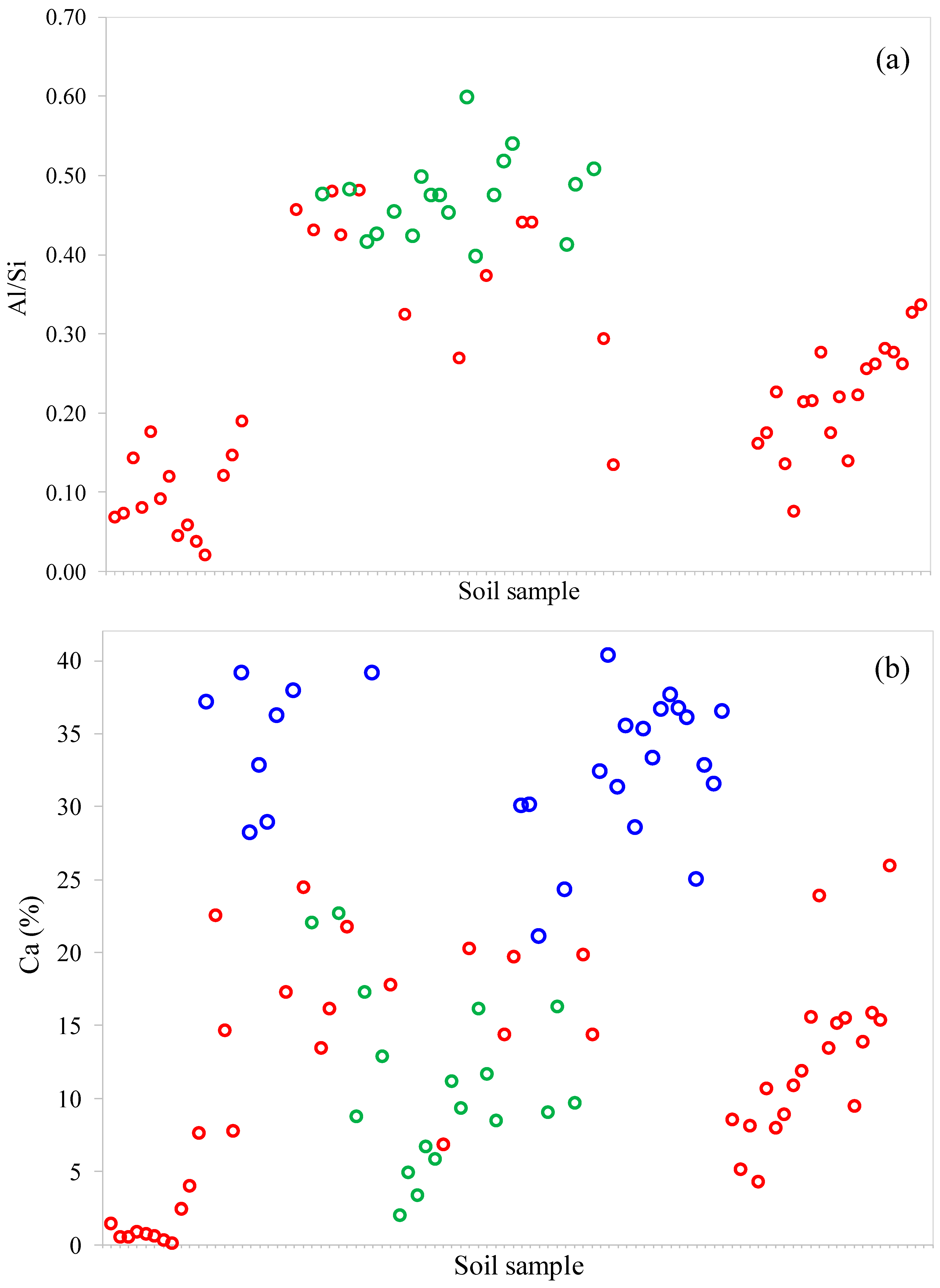

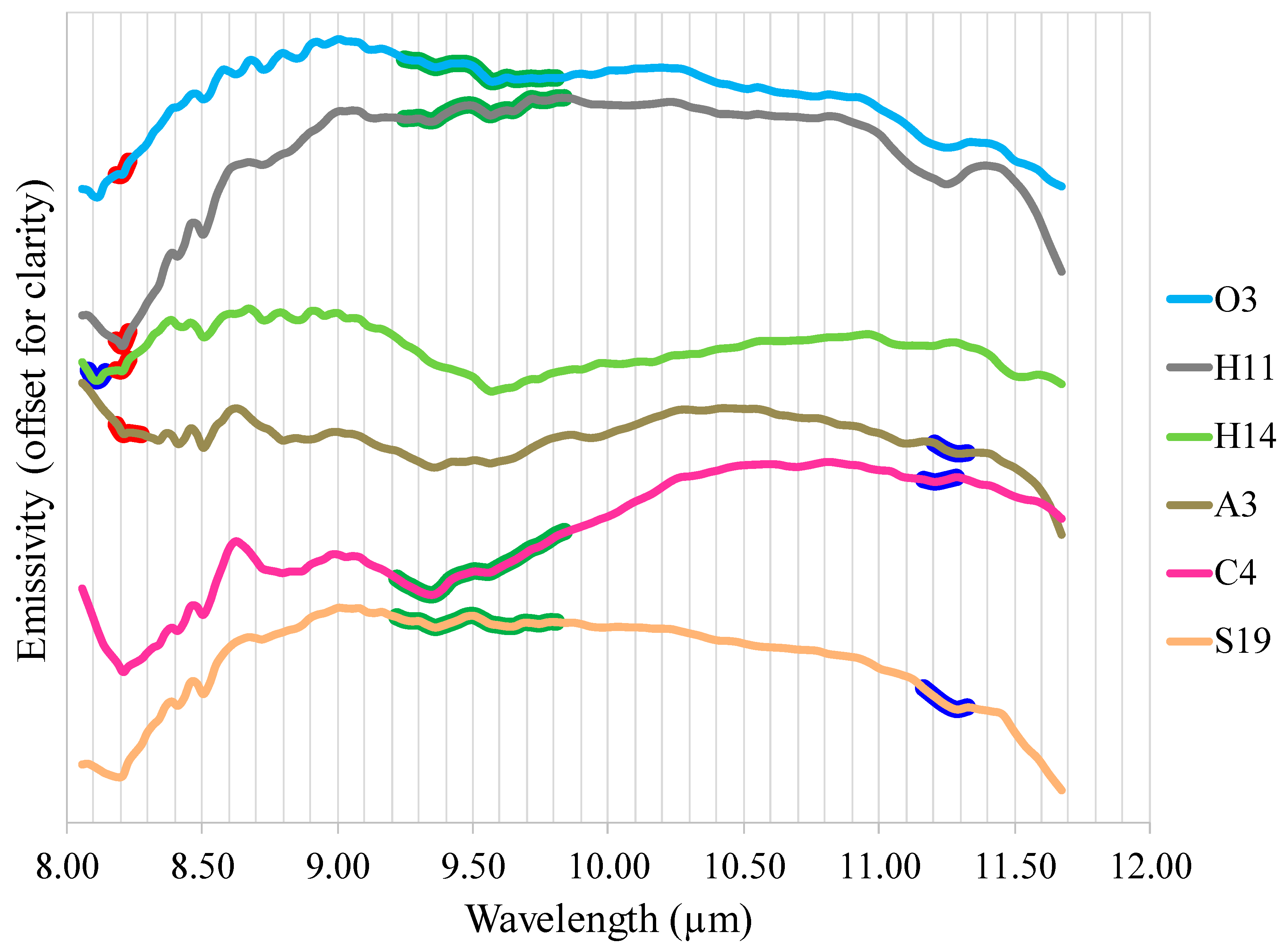

| Soil (Symbol, USDA Name) | Element Abundance (%) | Mineral Abundance (%) | ||||
|---|---|---|---|---|---|---|
| Si | Al | Ca | Quartz | Clay Minerals a | Carbonates b | |
| E2, Rhodoxeralf | 91.6 | 6.78 | 0.57 | 90 | 5 | 0 |
| E7, Rhodoxeralf | 87.2 | 10.5 | 0.30 | 75 | 15 | 1 |
| C4, Haploxeroll | 67.2 | 12.8 | 7.80 | 55 | 30 | 12 |
| B8, Haploxeroll | 42.0 | 17.8 | 17.3 | 30 | 40 | 31 |
| A3, Rhodoxeralf | 51.5 | 24.4 | 3.37 | 35 | 58 | 2 |
| H2, Xerert | 41.1 | 24.6 | 11.2 | 4 | 67 | 21 |
| K2, Calciorthid | 21.1 | 7.60 | 35.3 | 15 | 0 | 60 |
| O3, Torriorthent | 26.4 | 8.04 | 31.3 | 25 | 10 | 59 |
| P3, Torriorthent | 25.3 | 5.76 | 36.5 | 25 | 7 | 68 |
| H11, Haplargid | 29.7 | 4.44 | 30.1 | 36 | 10 | 54 |
| H14, Xerert | 38.4 | 18.7 | 16.3 | 25 | 45 | 28 |
| S19, Torriorthent | 35.4 | 11.9 | 26.0 | 47 | 10 | 43 |
| Most Abundant Mineral | Spectral Indicant |
|---|---|
| Clay minerals | Nελ = 9.56µma < Nελ = 8.21µm and Nελ = 8.21µm > 0.98 |
| Carbonates | ελ = 8.06-8.12µmb < ελ = 8.21µm and/or Nελ = 11.24µm < 0.995 with Nελ = 8.21µm > 0.98 |
| Quartz | Excluding the above |
| Soil Type | Indicant | Relative Amount of Mineral(s) |
|---|---|---|
| Q | SCI < 1.010 | C > CM |
| 1.010 ≤ SCI < 1.020 and SQCMI > 1.020 | C > CM | |
| SCI > 1.020 SCI > 1.050, SQCMI > 1.200 | CM > C no C, no CM | |
| CM | Absorption at 8.12 µm and/or SCI < 1.005 | C > Q |
| C | SQCMI > 1.010 with Nελ = 8.21µm < 0.990 | Q > CM |
| Soil | Type | Indicants | Mineralogy (More to Less Abundant) | |
|---|---|---|---|---|
| Spectral-Based | XRD Analysis | |||
| E2 | Q | SQCMI = 1.072, SCI = 1.041 | Q CM C | Q CM |
| E7 | Q | SQCMI = 1.033, SCI = 1.033 | Q CM C | Q CM C |
| C4 | Q | SQCMI = 1.015, SCI = 1.010 | Q CM C | Q CM C |
| B8 | CM | SCI = 1.004 | CM C Q | CM C Q |
| A3 | CM | SCI = 1.010 | CM Q C | CM Q C |
| H2 | CM | SCI = 1.008, absorption at 8.12 µm | CM C Q | CM C Q |
| K2 | C | SQCMI = 1.004 | C CM Q | C Q CM |
| O3 | C | SQCMI = 1.000 | C CM Q | C Q CM |
| P3 | C | SQCMI = 1.020 | C Q CM | C Q CM |
| H11 | C | SQCMI = 1.017, Nελ = 8.21µm = 0.983 | C Q CM | C Q CM |
| H14 | CM | SCI = 1.002, absorption at 8.12 µm | CM C Q | CM C Q |
| S19 | Q | SQCMI = 1.012, SCI = 0.997 | Q C CM | Q C CM |
© 2019 by the authors. Licensee MDPI, Basel, Switzerland. This article is an open access article distributed under the terms and conditions of the Creative Commons Attribution (CC BY) license (http://creativecommons.org/licenses/by/4.0/).
Share and Cite
Notesco, G.; Weksler, S.; Ben-Dor, E. Mineral Classification of Soils Using Hyperspectral Longwave Infrared (LWIR) Ground-Based Data. Remote Sens. 2019, 11, 1429. https://doi.org/10.3390/rs11121429
Notesco G, Weksler S, Ben-Dor E. Mineral Classification of Soils Using Hyperspectral Longwave Infrared (LWIR) Ground-Based Data. Remote Sensing. 2019; 11(12):1429. https://doi.org/10.3390/rs11121429
Chicago/Turabian StyleNotesco, Gila, Shahar Weksler, and Eyal Ben-Dor. 2019. "Mineral Classification of Soils Using Hyperspectral Longwave Infrared (LWIR) Ground-Based Data" Remote Sensing 11, no. 12: 1429. https://doi.org/10.3390/rs11121429
APA StyleNotesco, G., Weksler, S., & Ben-Dor, E. (2019). Mineral Classification of Soils Using Hyperspectral Longwave Infrared (LWIR) Ground-Based Data. Remote Sensing, 11(12), 1429. https://doi.org/10.3390/rs11121429





